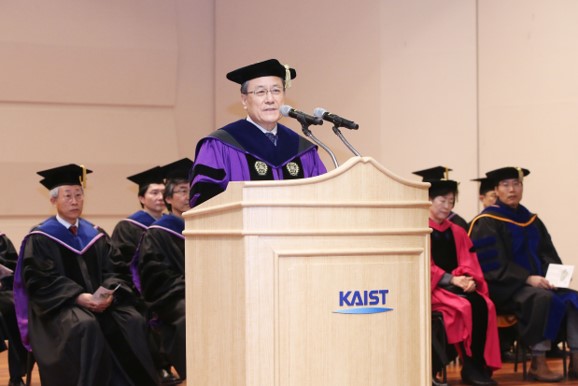policy

President Sung-Chul Shin welcomed 756 new undergraduates for 2017 during the Freshmen Convocation on February 27, urging them to be adamant in challenging themselves to become global leaders during the next four years and beyond at KAIST. Family, friends, faculty, and staff members cheered them on at the ceremony in the auditorium. The KAIST orchestra and chorus also celebrated the freshmen’s new start.
President Shin encouraged students to become global leaders by deepening their knowledge of basic studies as well as broadening their interdisciplinary spectrum while studying at KAIST.
“In the era of Industry 4.0, new discoveries will be made in interdisciplinary studies. Thus, I ask you to study humanities and social studies very diligently, the basis of creative research and development to broaden your knowledge spectrum. Conventionally, the science and technology fields are dominated by left-sided brains working while the humanities and social sciences are influenced by the right brain. KAIST will soon provide a new curriculum of full-brain teaching which will actively stimulate both sides of the brain. Such a new track will help students fully exercise their ingenuity, especially in comprehending the newest trends of science and technology,” he said.
He added, “Korea stands as one of seven most innovative nations with significant growth potential and the world is paying attention to us. You are the top 0.3 percent of science and technology talents in the nation who will be the leaders of our future. Thus, we plan to establish the Global Leadership Center in order to train our students to be outstanding leaders through their qualifications, manner, and mindset.”
He also cited communication skills as a critical aspect that every student, especially those majoring in science and technology, should focus on. “Communication is a critical tool for any scientist and leader. Students should study and learn how to better present themselves and deliver what they think more effectively and persuasively to others in the hyper-connected, horizontal society of the future. In particular, English communication skills are very crucial for engaging in leadership roles on the global stage.”
Finally, President Shin asked students to manage their time well in order to accomplish their goals. “Your future will be determined by what dreams you dream in college and how you prepare for it. I hope that your days at KAIST will be a time of diligent preparation for your ambitious dreams,” he added.
For full context of his speech, please click.

(Photo caption: President Shin makes a welcoming address at the 2017 Freshmen Convocation (above) and freshmen representatives present the oath of freshmen to President Shin.)
-
event KAIST Takes the Lead in Developing Core Technologies for Generative AI National R&D Project
KAIST (President Kwang Hyung Lee) is leading the transition to AI Transformation (AX) by advancing research topics based on the practical technological demands of industries, fostering AI talent, and demonstrating research outcomes in industrial settings. In this context, KAIST announced on the 13th of August that it is at the forefront of strengthening the nation's AI technology competitiveness by developing core AI technologies via national R&D projects for generative AI led by the Minis
2025-08-13 -
research KAIST Develops World’s First Wireless OLED Contact Lens for Retinal Diagnostics
<ID-style photograph against a laboratory background featuring an OLED contact lens sample (center), flanked by the principal authors (left: Professor Seunghyup Yoo ; right: Dr. Jee Hoon Sim). Above them (from top to bottom) are: Professor Se Joon Woo, Professor Sei Kwang Hahn, Dr. Su-Bon Kim, and Dr. Hyeonwook Chae> Electroretinography (ERG) is an ophthalmic diagnostic method used to determine whether the retina is functioning normally. It is widely employed for diagnosing hereditary
2025-08-12 -
research KAIST Develops AI That Automatically Designs Optimal Drug Candidates for Cancer-Targeting Mutations
< (From left) Ph.D candidate Wonho Zhung, Ph.D cadidate Joongwon Lee , Prof. Woo Young Kim , Ph.D candidate Jisu Seo > Traditional drug development methods involve identifying a target protin (e.g., a cancer cell receptor) that causes disease, and then searching through countless molecular candidates (potential drugs) that could bind to that protein and block its function. This process is costly, time-consuming, and has a low success rate. KAIST researchers have developed an AI model th
2025-08-12 -
research KAIST Develops Bioelectrosynthesis Platform for Switch-Like Precision Control of Cell Signaling
<(From left)Professor Jimin Park, Ph.D candidate Myeongeun Lee, Ph.D cadidate Jaewoong Lee,Professor Jihan Kim> Cells use various signaling molecules to regulate the nervous, immune, and vascular systems. Among these, nitric oxide (NO) and ammonia (NH₃) play important roles, but their chemical instability and gaseous nature make them difficult to generate or control externally. A KAIST research team has developed a platform that generates specific signaling molecules in situ from a si
2025-08-12 -
event 2025 APEC Youth STEM Science Exchange Program Successfully Completed
<Photo1. Group photo at the end of the program> KAIST (President Kwang Hyung Lee) announced on the 11thof August that it successfully hosted the 'APEC Youth STEM Conference KAIST Academic Program,' a global science exchange program for 28 youth researchers from 10 countries and over 30 experts who participated in the '2025 APEC Youth STEM* Collaborative Research and Competition.' The event was held at the main campus in Daejeon on Saturday, August 9. STEM (Science, Technology, Eng
2025-08-11